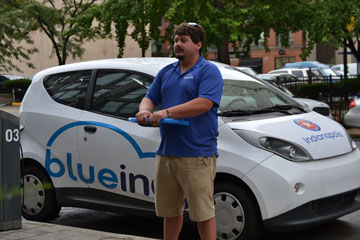
Indianapolis plans to implement BlueIndy, an electric car share program involving 500 electric cars, newly developed by the Bollore Group, a French company in charge of the program. The city has planned for the new cars to be set up in approximately 200 locations around Indianapolis starting this December.
According to BlueIndy’s website, drivers can reserve a car online, at a BlueIndy kiosk or from a smartphone for either a single use or through an optional membership. These cars can be picked up and dropped off at any of the 1000 charging stations around Indianapolis.
According to junior Dana Wang, who said she plans on using the program, there are many benefits to BlueIndy.
Wang said, “(BlueIndy) is beneficial to both people and the environment (because) it will give off less pollution and make Indianapolis more green. Also, by (car sharing), there will be less cars on the streets which means that traffic won’t be as bad.”
Junior Marly Rizkalla, however, disagrees with Wang and said BlueIndy is only beneficial to those who don’t already have a car.
Rizkalla said, “This program is a great benefit for those who can’t afford to pay for a car, but I wouldn’t consider using the service. Although it’s a great deal, I already have my own car.”
BlueIndy’s website said the new cars are 100 percent electric, emitting no carbon dioxide, and they run on recyclable Lithium Metal Polymer (LMP) batteries, so car users are not responsible for car fuel.
Wang said the cars’ technological features along with the pricing of the BlueIndy program and the fact that she does not need to pay insurance make her likely to participate.
“I do agree with the pricing of (about) $13 per month for a membership because it is easily affordable for many people who otherwise would have to walk or find some other mode of transportation. By renting one of these cars, I could forgo buying a car myself, which would save lots of money that could be used for other purposes,” she said.
Wang said there are also potential consequences for BlueIndy,
Wang said, “Some consequences include that there could be a small response to this program, which would counteract all of the time, money, and effort put into this program.”
Furthermore, Wang said the program might not receive a big response because the car charging stations are only in Indianapolis so it may be difficult for people who live in other cities or who travel frequently to use the program.
Wang said, “I think the program itself is very convenient, however, only for those who live near a station where the cars are. For those who live further away, it may not even be worth the effort to try out the program.”
However, overall, Wang and Rizkalla both said they agree that the program will be beneficial for Indianapolis residents and are interested in seeing how it turns out.
Wang said, “I don’t see (BlueIndy) taking over the car industry in the future because even though this is a good green effort idea, many people will find it more convenient to own their own personal vehicles for travel. But some people, (such as) students and other residents here who don’t have a car will benefit most.”

































![AI in films like "The Brutalist" is convenient, but shouldn’t take priority [opinion]](https://hilite.org/wp-content/uploads/2025/02/catherine-cover-1200x471.jpg)









































![Review: “The Immortal Soul Salvage Yard:” A criminally underrated poetry collection [MUSE]](https://hilite.org/wp-content/uploads/2025/03/71cju6TvqmL._AC_UF10001000_QL80_.jpg)
![Review: "Dog Man" is Unapologetically Chaotic [MUSE]](https://hilite.org/wp-content/uploads/2025/03/dogman-1200x700.jpg)
![Review: "Ne Zha 2": The WeChat family reunion I didn’t know I needed [MUSE]](https://hilite.org/wp-content/uploads/2025/03/unnamed-4.png)
![Review in Print: Maripaz Villar brings a delightfully unique style to the world of WEBTOON [MUSE]](https://hilite.org/wp-content/uploads/2023/12/maripazcover-1200x960.jpg)
![Review: “The Sword of Kaigen” is a masterpiece [MUSE]](https://hilite.org/wp-content/uploads/2023/11/Screenshot-2023-11-26-201051.png)
![Review: Gateron Oil Kings, great linear switches, okay price [MUSE]](https://hilite.org/wp-content/uploads/2023/11/Screenshot-2023-11-26-200553.png)
![Review: “A Haunting in Venice” is a significant improvement from other Agatha Christie adaptations [MUSE]](https://hilite.org/wp-content/uploads/2023/11/e7ee2938a6d422669771bce6d8088521.jpg)
![Review: A Thanksgiving story from elementary school, still just as interesting [MUSE]](https://hilite.org/wp-content/uploads/2023/11/Screenshot-2023-11-26-195514-987x1200.png)
![Review: "When I Fly Towards You", cute, uplifting youth drama [MUSE]](https://hilite.org/wp-content/uploads/2023/09/When-I-Fly-Towards-You-Chinese-drama.png)
![Postcards from Muse: Hawaii Travel Diary [MUSE]](https://hilite.org/wp-content/uploads/2023/09/My-project-1-1200x1200.jpg)
![Review: "Ladybug & Cat Noir: The Movie," departure from original show [MUSE]](https://hilite.org/wp-content/uploads/2023/09/Ladybug__Cat_Noir_-_The_Movie_poster.jpg)
![Review in Print: "Hidden Love" is the cute, uplifting drama everyone needs [MUSE]](https://hilite.org/wp-content/uploads/2023/09/hiddenlovecover-e1693597208225-1030x1200.png)
![Review in Print: "Heartstopper" is the heartwarming queer romance we all need [MUSE]](https://hilite.org/wp-content/uploads/2023/08/museheartstoppercover-1200x654.png)




